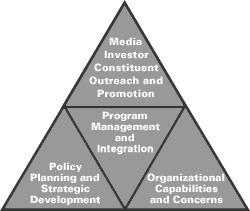|
Approach
KWR's unique methodology moves far beyond traditional public and investor relations. Utilizing a comprehensive approach, we employ a multi-step process that recognizes the integrated nature of most communications, financial, business and public affairs objectives. This enables our clients to integrate research and media with investor outreach and promotion in a manner that enhances their strategic planning and organizational capabilities.
KWR encourages our clients to view their public image as being roughly equivalent to a financial security. The objective is then to maximize its “price” in a sustainable manner to enhance its underlying value. This can be achieved through a concept that we term “efficient communications” theory.
Efficient communications theory maintains that most people assume a free flow of public information and institutions will take the steps necessary to promote their interests. They believe that publicly available information incorporates the best efforts of an institution to tell its side of a story, irrespective of the actual effort that has been made.
The larger and more prominent the institution, the greater potential there is for a gap between perceptions and underlying performance or potential. This is true as most people expect governments and major corporations to expend considerable resources to promote their public image. They assume that media coverage incorporates the best efforts of an institution to put itself in the best possible light. In many cases, a discount factor is then applied to ascertain the reality from the “hype”.
This approach is derived from the "efficient markets" theory that serves as a cornerstone of modern finance. Efficient markets theory states that on average -- given a free flow of information -- listed securities are priced fairly as their price reflects the consensus opinion after all market participants have evaluated all relevant information.
Over the long term – no matter how brilliant and well developed – communications programs need to be based on an underlying foundation of good policy and sharp strategic focus. They must also be scaled in accordance with the capabilities and concern of the client organization. To do otherwise leads to imbalances in the form of perception “deficits”, where the real potential and achievements of a client are not properly recognized or “surpluses”, where expectations become unrealistically inflated.
Both of these imbalances can have negative implications.
A perception deficit can raise an institution's cost of capital, both
figuratively and literally. A surplus, however, has the opposite effect.
If effectively managed it can be seen as a subsidy that can add value.
The problem, however, as seen in the recent Internet bubble, is that
it can lead to speculative excesses and rarely proves sustainable over
time.
KWR’s appreciation of the nuances of corporate and public policy is derived from our ability to provide a wide range of research and analytical expertise. Similarly, our extensive experience working with public and private sector entities of all types and sizes allows us to scale projects that best meet the unique needs, requirements and resources of a particular organization. This helps to ensure that clients are served in the manner that positions them for maximum effect and momentum.
The following diagram depicts the integrated nature of these tasks and has been developed by KWR to assist its clients in developing communications and business development programs.
|
 |
|
©2001 KWR International
|
Traditional public and investor relations programs usually focus on message delivery and outwardly oriented promotion. The emphasis is generally placed on tactics and implementation, without paying adequate attention to organizational, technical and strategic concerns. Integrated communications balances these dependent factors, placing them into a cohesive integrated structure, designed to promote the needs of the client and to generate real and sustainable results.
Each of these elements depicted above is as strong and as important as the others. Media outreach and promotion must remain in equilibrium with business, financial and institutional strategies and policies as well as organizational capabilities and concerns. Without an appropriate emphasis on policy, planning and strategic development, it is pointless to undertake outreach and promotion. Similarly, a corporation, government agency or institution must have the necessary infrastructure in place to handle the added demands generated through effective outreach. Each of these focuses must be balanced through effective program or project management.
Website content © 2001 KWR International |



